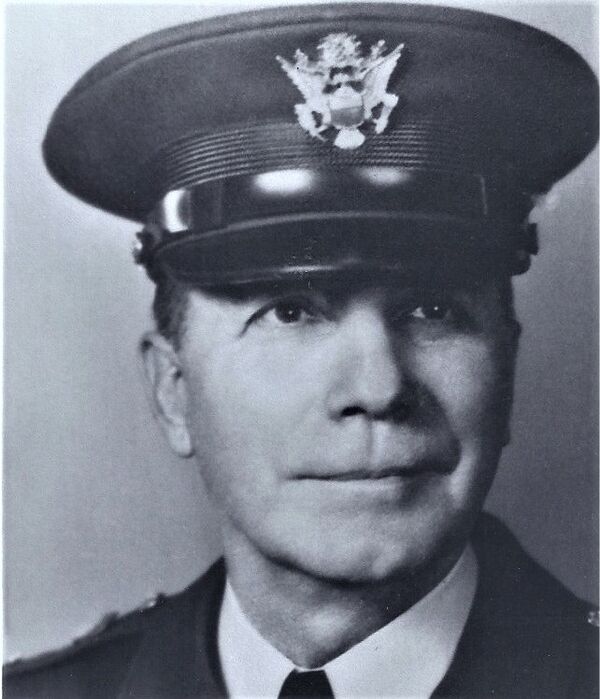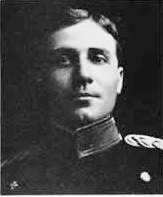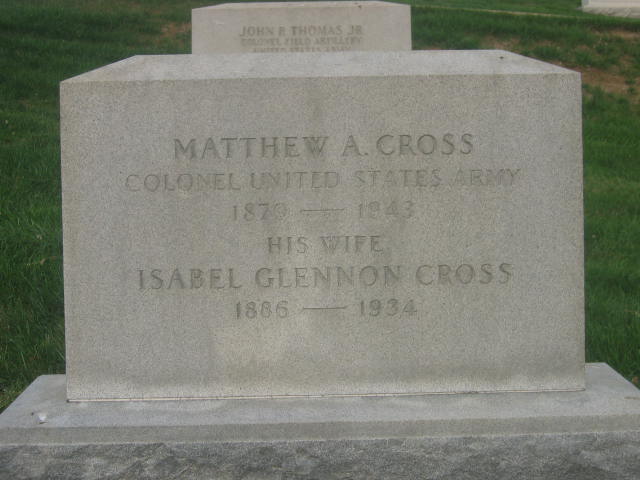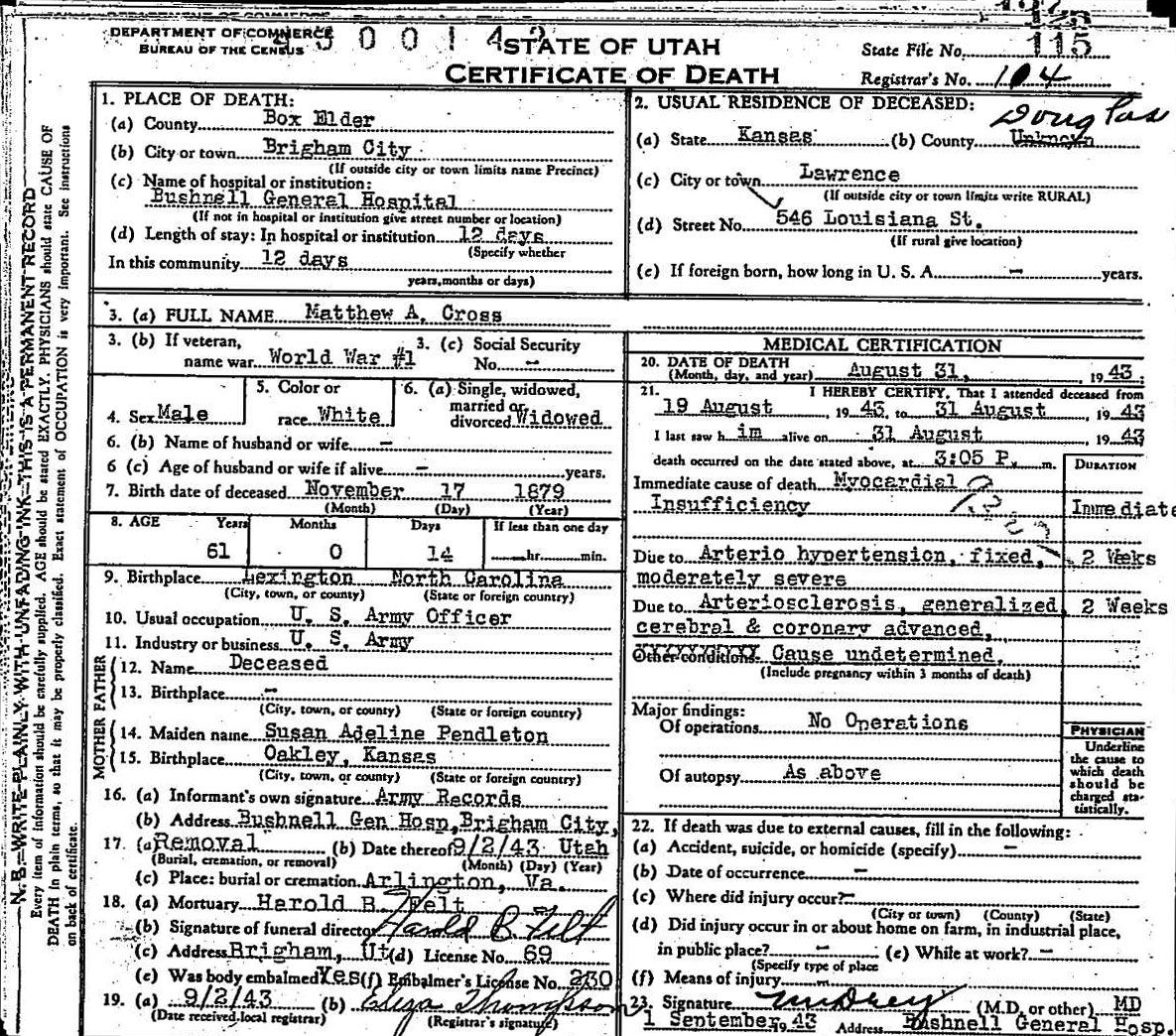About January 1, 1889, the family moved from the ranch to Wakeeney, Kansas the county seat of Trego County when his father had been elected to the office of Recorder of the county. He graduated from the grade school in Wakeeney in 1893 and from the Wakeeney High School in 1897.
He attended the University of Kansas at Lawrence during the years 1897-1898 and 1899-1900. He taught school in Trego County, Kansas in 1898-1899. In the summer of 1899, he took an examination for admission to West Point. On March 15, 1900, he was informed by the War Department that he had successfully passed the requirements but that the Principal appointed by Congressman Reeder had also passed. He was appointed alternate by Congressman Reeder of the 6th District of Kansas.
In August, 1900, The Principal resigned and the alternate then became eligible. He therefore went to the Military Academy in September, 1900 after he had already returned to the University of Kansas at Lawrence for his junior year.
The delay in entering the Academy created a difficult situation for him and he seriously considered withdrawing until the regular time of entrance the following June. He continued however and graduated with his class in 1904. Because of his having entered in September, he was known throughout his life at West Point and the Army as "Sep” Cross. He ranked toward the top of the class and was assigned to the artillery as a 2nd Lieutenant. He was stationed at Fort Myer, Va. where he served until June 7, 1905 with the 4th Battery F. A. On June 8, 1905, he was stationed at Fort Ethan Allen, Vt. where he remained until June 30, 1906 with the 23rd Battery F. A.
On July 1, 1906, he was promoted to 1st Lieutenant of Ordnance and stationed at Sandy Hook Proving Ground, N. J. at the entrance of New York harbor where he remained until June 25, 1907. At Sandy Hook, he was Proof Officer, Student Officer at the Ordnance School of Application and Commanding Officer of Detachment Ordnance.
He was returned to the Coast Artillery as 1st Lieutenant on January 25, 1907 and later transferred on June 26, 1907 to Springfield Armory, Springfield, Mass., where he remained until June 30, 1908.
On July 1, 1908 he was transferred to Fort McKinley, Maine commanding the 37th Company (Mine) C.A.C.
On August 21, 1909, he was appointed instructor in the Department of Natural and Experimental Philosophy at West Point, becoming Assistant Professor in 1911.
On December 14, 1912, he was assigned to Fort Totten, N.Y. serving there until August 12, 1915. During this interval, he served with the 135th Company C.A.C. and the 101st Company, C. A. C. While at Fort Totten, he was promoted to Captain of the Coast Artillery and was also relieved on August 16, 1914 to serve on the American Relief Expedition in charge of disbursement of funds to stranded Americans on the European Continent, particularly in Germany, Austria and Hungary. He was also privileged to take observations in the German Army in the field. He returned to America, October 9, 1914.
In August, 1915, he was assigned to Fort Randolph, Panama Canal Zone, where he served for two years until the United States entered the war against Germany. He returned to the States about August 1, 1917. While at Fort Randolph, he was Fort Commander, Captain of the 21st Company, C.A.C., member of the Fire Control Board and Constructing Quartermaster.
On September 1, 1917, he sailed on board the steamship "Aurania", the first contingent of the American Expeditionary Forces, World War I, in command of Company "H" 7th Regiment Coast Artillery. He arrived at Southampton, England, September 11, 1917 and sailed on the "Marguerite" on the same day for Havre, France, arriving early in the morning of September 12, 1917.
The papers of Col. Cross from this time on in France are not very complete but he served as the Head of the Saumur Artillery School in France ("Director of Instruction"). General Pershing, according to letters and photographs, visited the Saumur Artillery School in France late in 1918 and subsequently a French officer wrote a very complimentary letter to Col. Cross relative to the Pershing inspection.
After the Armistice of November 11, 1918, Col. Cross was assigned to the Occupational Forces in Coblenz, apparently still with the 7th Artillery. He remained at Coblenz until about April 20, 1919. Col. Cross returned to the United States about April 24, 1919 and was appointed to the General Staff where he was especially active in helping prepare army appropriation measures for presentation to Congress.
He was very helpful in suggesting the modification of the equipment for making big naval guns at the Bethlehem and Midvale Steel Works for use in the manufacture of the huge high pressure reaction chambers for manufacture of gasoline by the process developed by Dr. Roy Cross and Dr. Walter Cross of the Gasoline Products Company.
While on the General Staff, he made special inspections in 1919 at Camp Zachary Taylor, Camp Grant and Camp Funston. He continued with the Staff during 1920 and 1921 as Chief of Personnel Data Sub-Section. He subsequently attended and graduated from both the Command and General Staff School at Leavenworth and the Army War College in Washington, D. C. He was appointed Director of the Department of Military Art at the Coast Artillery School at Fort Monroe, Va. in 1927 where he apparently remained until 1930.
In 1928 he was given the permanent rank of Lieutenant Col.
He was then appointed Commandant of Fort MacArthur near Los Angeles in 1930 where he remained until 1932. During the time he was at Fort MacArthur, he installed the first antiaircraft battery and maneuvers were carried out throughout the Mojave Desert and the Yosemite Valley. This was the first anti-aircraft on the West Coast and included not only the most modern guns but also searchlights and detectors. He was in command of the 63rd Coast Artillery which then became an anti-aircraft regiment. He also carried out maneuvers around San Diego.
In 1932, Col. Cross was sent to Fort Mills on Corregidor Island at the entrance to Manila Bay in the Philippines where he remained until 1935. He then returned to Washington and was subjected to a physical examination at the Walter Reed Hospital having been placed on the eligible list for promotion. He was promoted to Col. in the Coast Artillery Corps on August 15, 1935.
Isabel Glennon Cross, his wife and the daughter of Admiral Glennon died while Col. Cross was in the Philippines.
In 1936, he was assigned to Cleveland in charge of the Organized Reserves. While at Cleveland, he inspected R.O.T.C. camps and was in temporary charge of R.O.T.C. camps at Fort Sheridan and other points. In 1938 and 1939 he was an umpire of the war games at Fort Knox, Ky.
In 1938, he was apparently again on the eligible list for promotion (to Brigadier General) and was sent to the Walter Reed Hospital for a check-up. It was while there that he was reported as having excessive blood pressure and his recommendation was held up due to the medical officers report.
He remained in Cleveland until September, 1939 when he was sent to Logan, Utah in charge of the R.O.T.C. at the Utah State Agricultural College and was Professor of Military Science and Tactics. He remained in Utah until his illness in 1943. He died August 31, 1943 at the Bushnell General Hospital, Brigham City, Utah of cardiac insufficiency just a few days before his scheduled retirement from the Army, exactly 43 years after he began his service with the U.S. Army.
He is survived by his daughter Edith Blair Cross of Washington, D.C., two brothers, Dr. Roy Cross of Kansas City and Fred Cross of Ellis, Kansas, a sister, Edith Cross Hall of Oakley, Kansas and his mother, Ada Pendleton Cross of Oakley, Kansas. Colonel Cross was especially known for his pleasant bearing and sympathetic attitude toward everyone with whom he came into contact. He was most loyal to all of his friends, relatives and associates. He had the analytical mind of a mathematician and the literary style of a writer. As a youth he was particularly attracted toward legal work but was diverted to the army. As a boy he loved to visit court rooms and return home to orate to the family as the lawyer did to the jury. In later life he was much interested in photography particularly movies and color pictures. Throughout his life he continued his family solidity, friendliness, warm heartedness, and love of literature, mathematics and law. Had he so chosen, he would have been successful as a writer, a lawyer, a mathematician or a teacher. He was by nature not methodical or precise enough for a military life. His military bearing and history indicate the opposite by reason of his training at West Point and his complete control of himself in all situations. Privately, in citizens clothes he could revert to his natural lovable character but in his official capacity he was a stickler for perfection of form, strict attention to duty and exact conformance to military regulations and standards.
At West Point and in immediate subsequent years, he was very active socially and in these surroundings, he met one of the most beautiful girls in Washington society. She was Isabel Glennon, the daughter of Admiral Glennon. Lt. Cross married Isabel on Wednesday, April 17, 1907. Their daughter, Edith Blair Cross was born January 26, 1908. It was at the Walter Reed Hospital in 1934 that it was found that Isabel was suffering from a brain tumor and during the time that preparations were actually made for an operation to relieve her of this difficulty, she died October, 1934 while Col. Cross was on duty in the Philippine Islands. The shock of Isabel’a death may have been a contributing factor to the development of high blood pressure and arterial sclerosis.
When he was appointed as Professor of Military Tactics at the Utah State Agricultural College, he became associated with very congenial people, yet he still desired to re-associate himself with his relatives and friends in Kansas. He returned to Lawrence for retirement where he bought a house.
He was buried at Arlington Cemetery, September 8, 1943 alongside the grave of Isabel Glennon Cross, his wife.
-------------------------
NARA War Department records list this soldiers Home of Record as Ellis County, Kansas...Died Non-Battle
About January 1, 1889, the family moved from the ranch to Wakeeney, Kansas the county seat of Trego County when his father had been elected to the office of Recorder of the county. He graduated from the grade school in Wakeeney in 1893 and from the Wakeeney High School in 1897.
He attended the University of Kansas at Lawrence during the years 1897-1898 and 1899-1900. He taught school in Trego County, Kansas in 1898-1899. In the summer of 1899, he took an examination for admission to West Point. On March 15, 1900, he was informed by the War Department that he had successfully passed the requirements but that the Principal appointed by Congressman Reeder had also passed. He was appointed alternate by Congressman Reeder of the 6th District of Kansas.
In August, 1900, The Principal resigned and the alternate then became eligible. He therefore went to the Military Academy in September, 1900 after he had already returned to the University of Kansas at Lawrence for his junior year.
The delay in entering the Academy created a difficult situation for him and he seriously considered withdrawing until the regular time of entrance the following June. He continued however and graduated with his class in 1904. Because of his having entered in September, he was known throughout his life at West Point and the Army as "Sep” Cross. He ranked toward the top of the class and was assigned to the artillery as a 2nd Lieutenant. He was stationed at Fort Myer, Va. where he served until June 7, 1905 with the 4th Battery F. A. On June 8, 1905, he was stationed at Fort Ethan Allen, Vt. where he remained until June 30, 1906 with the 23rd Battery F. A.
On July 1, 1906, he was promoted to 1st Lieutenant of Ordnance and stationed at Sandy Hook Proving Ground, N. J. at the entrance of New York harbor where he remained until June 25, 1907. At Sandy Hook, he was Proof Officer, Student Officer at the Ordnance School of Application and Commanding Officer of Detachment Ordnance.
He was returned to the Coast Artillery as 1st Lieutenant on January 25, 1907 and later transferred on June 26, 1907 to Springfield Armory, Springfield, Mass., where he remained until June 30, 1908.
On July 1, 1908 he was transferred to Fort McKinley, Maine commanding the 37th Company (Mine) C.A.C.
On August 21, 1909, he was appointed instructor in the Department of Natural and Experimental Philosophy at West Point, becoming Assistant Professor in 1911.
On December 14, 1912, he was assigned to Fort Totten, N.Y. serving there until August 12, 1915. During this interval, he served with the 135th Company C.A.C. and the 101st Company, C. A. C. While at Fort Totten, he was promoted to Captain of the Coast Artillery and was also relieved on August 16, 1914 to serve on the American Relief Expedition in charge of disbursement of funds to stranded Americans on the European Continent, particularly in Germany, Austria and Hungary. He was also privileged to take observations in the German Army in the field. He returned to America, October 9, 1914.
In August, 1915, he was assigned to Fort Randolph, Panama Canal Zone, where he served for two years until the United States entered the war against Germany. He returned to the States about August 1, 1917. While at Fort Randolph, he was Fort Commander, Captain of the 21st Company, C.A.C., member of the Fire Control Board and Constructing Quartermaster.
On September 1, 1917, he sailed on board the steamship "Aurania", the first contingent of the American Expeditionary Forces, World War I, in command of Company "H" 7th Regiment Coast Artillery. He arrived at Southampton, England, September 11, 1917 and sailed on the "Marguerite" on the same day for Havre, France, arriving early in the morning of September 12, 1917.
The papers of Col. Cross from this time on in France are not very complete but he served as the Head of the Saumur Artillery School in France ("Director of Instruction"). General Pershing, according to letters and photographs, visited the Saumur Artillery School in France late in 1918 and subsequently a French officer wrote a very complimentary letter to Col. Cross relative to the Pershing inspection.
After the Armistice of November 11, 1918, Col. Cross was assigned to the Occupational Forces in Coblenz, apparently still with the 7th Artillery. He remained at Coblenz until about April 20, 1919. Col. Cross returned to the United States about April 24, 1919 and was appointed to the General Staff where he was especially active in helping prepare army appropriation measures for presentation to Congress.
He was very helpful in suggesting the modification of the equipment for making big naval guns at the Bethlehem and Midvale Steel Works for use in the manufacture of the huge high pressure reaction chambers for manufacture of gasoline by the process developed by Dr. Roy Cross and Dr. Walter Cross of the Gasoline Products Company.
While on the General Staff, he made special inspections in 1919 at Camp Zachary Taylor, Camp Grant and Camp Funston. He continued with the Staff during 1920 and 1921 as Chief of Personnel Data Sub-Section. He subsequently attended and graduated from both the Command and General Staff School at Leavenworth and the Army War College in Washington, D. C. He was appointed Director of the Department of Military Art at the Coast Artillery School at Fort Monroe, Va. in 1927 where he apparently remained until 1930.
In 1928 he was given the permanent rank of Lieutenant Col.
He was then appointed Commandant of Fort MacArthur near Los Angeles in 1930 where he remained until 1932. During the time he was at Fort MacArthur, he installed the first antiaircraft battery and maneuvers were carried out throughout the Mojave Desert and the Yosemite Valley. This was the first anti-aircraft on the West Coast and included not only the most modern guns but also searchlights and detectors. He was in command of the 63rd Coast Artillery which then became an anti-aircraft regiment. He also carried out maneuvers around San Diego.
In 1932, Col. Cross was sent to Fort Mills on Corregidor Island at the entrance to Manila Bay in the Philippines where he remained until 1935. He then returned to Washington and was subjected to a physical examination at the Walter Reed Hospital having been placed on the eligible list for promotion. He was promoted to Col. in the Coast Artillery Corps on August 15, 1935.
Isabel Glennon Cross, his wife and the daughter of Admiral Glennon died while Col. Cross was in the Philippines.
In 1936, he was assigned to Cleveland in charge of the Organized Reserves. While at Cleveland, he inspected R.O.T.C. camps and was in temporary charge of R.O.T.C. camps at Fort Sheridan and other points. In 1938 and 1939 he was an umpire of the war games at Fort Knox, Ky.
In 1938, he was apparently again on the eligible list for promotion (to Brigadier General) and was sent to the Walter Reed Hospital for a check-up. It was while there that he was reported as having excessive blood pressure and his recommendation was held up due to the medical officers report.
He remained in Cleveland until September, 1939 when he was sent to Logan, Utah in charge of the R.O.T.C. at the Utah State Agricultural College and was Professor of Military Science and Tactics. He remained in Utah until his illness in 1943. He died August 31, 1943 at the Bushnell General Hospital, Brigham City, Utah of cardiac insufficiency just a few days before his scheduled retirement from the Army, exactly 43 years after he began his service with the U.S. Army.
He is survived by his daughter Edith Blair Cross of Washington, D.C., two brothers, Dr. Roy Cross of Kansas City and Fred Cross of Ellis, Kansas, a sister, Edith Cross Hall of Oakley, Kansas and his mother, Ada Pendleton Cross of Oakley, Kansas. Colonel Cross was especially known for his pleasant bearing and sympathetic attitude toward everyone with whom he came into contact. He was most loyal to all of his friends, relatives and associates. He had the analytical mind of a mathematician and the literary style of a writer. As a youth he was particularly attracted toward legal work but was diverted to the army. As a boy he loved to visit court rooms and return home to orate to the family as the lawyer did to the jury. In later life he was much interested in photography particularly movies and color pictures. Throughout his life he continued his family solidity, friendliness, warm heartedness, and love of literature, mathematics and law. Had he so chosen, he would have been successful as a writer, a lawyer, a mathematician or a teacher. He was by nature not methodical or precise enough for a military life. His military bearing and history indicate the opposite by reason of his training at West Point and his complete control of himself in all situations. Privately, in citizens clothes he could revert to his natural lovable character but in his official capacity he was a stickler for perfection of form, strict attention to duty and exact conformance to military regulations and standards.
At West Point and in immediate subsequent years, he was very active socially and in these surroundings, he met one of the most beautiful girls in Washington society. She was Isabel Glennon, the daughter of Admiral Glennon. Lt. Cross married Isabel on Wednesday, April 17, 1907. Their daughter, Edith Blair Cross was born January 26, 1908. It was at the Walter Reed Hospital in 1934 that it was found that Isabel was suffering from a brain tumor and during the time that preparations were actually made for an operation to relieve her of this difficulty, she died October, 1934 while Col. Cross was on duty in the Philippine Islands. The shock of Isabel’a death may have been a contributing factor to the development of high blood pressure and arterial sclerosis.
When he was appointed as Professor of Military Tactics at the Utah State Agricultural College, he became associated with very congenial people, yet he still desired to re-associate himself with his relatives and friends in Kansas. He returned to Lawrence for retirement where he bought a house.
He was buried at Arlington Cemetery, September 8, 1943 alongside the grave of Isabel Glennon Cross, his wife.
-------------------------
NARA War Department records list this soldiers Home of Record as Ellis County, Kansas...Died Non-Battle
Gravesite Details
COLONEL COAST ART US ARMY RET
Family Members
Sponsored by Ancestry
Advertisement
Records on Ancestry
Advertisement



















